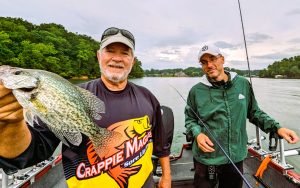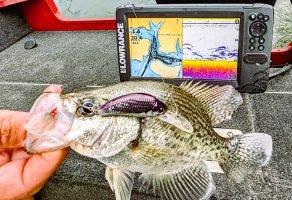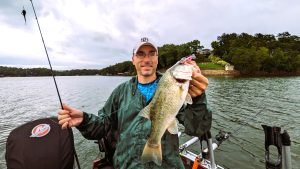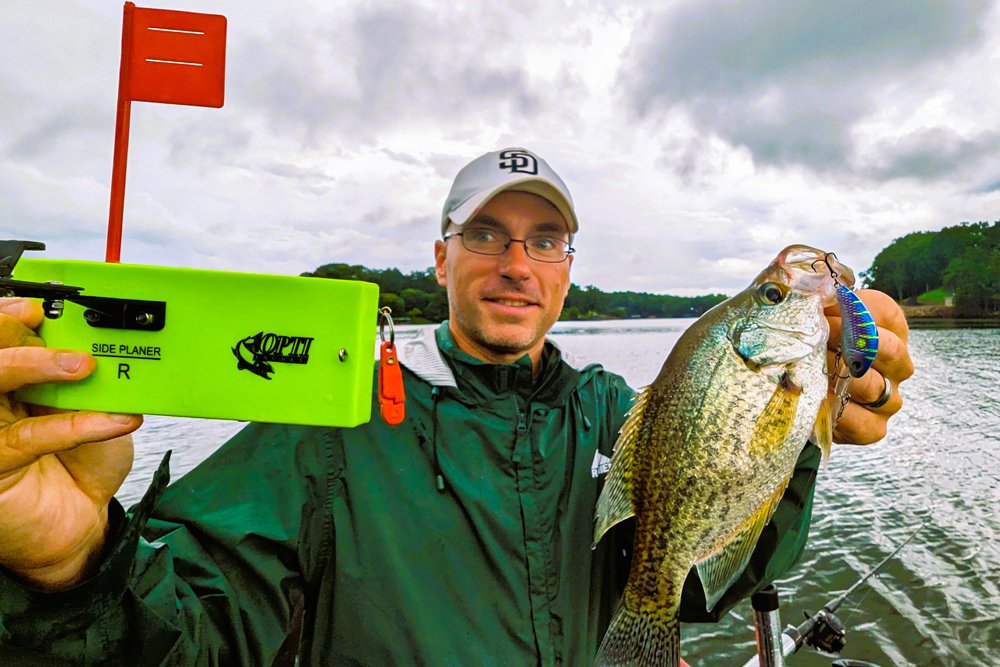Capt. Scott Lilly employs planer boards to place the Boogie Shad 5 away from
the boat in the clear water conditions of summer. (Photo: Terry Madewell)
Cranking Crappies on Chickamauga Lake
by Terry Madewell
I arrived at the Chester Frost Park boat ramp on Chickamauga Lake early, planning to sip coffee and watch a sunrise before meeting Scenic City Fishing Charters fishing guide Scott Lillie. But Lillie’s rig was the lone truck/boat rig in the parking lot when I pulled up. He was already prepped and ready to go.
But ole Ma Nature intervened with a flurry of pre-dawn thundershowers, coupled with lightening, so I did sip coffee while discussing catching crappie on crankbaits with Capt. Lillie. It was a perfect primer for me prior to fishing in a manner that I’d never employed.
The threatening weather moved out, and Capt. Lillie decided it was safe to get underway. We fished TVA’s Chickamauga Lake, on the mighty Tennessee River, targeting slab crappie with crankbaits. Chickamauga Lake extends 59 miles upstream to Watts Bar Dam, inundating about 36,000 acres of water.

Capt. Lillie, 44, lives in Soddy-Daisy, a community not far from Chattanooga. He splits his piscatorial pursuits from targeting slab crappie in the spring and summer to whacking walleyes in cold weather. He also teaches school, coaches’ football and is married with children. Busy dude.
Storms may have delayed our launch, but the pace of the crappie-catching action erased that issue. Within five minutes on our first trolling pass Lillie had us connected to slabs.
This was a special ‘homecoming’ trip for me, because I grew up in Soddy-Daisy myself, fishing Chickamauga Lake with a passion until moving for work after college. I graduated from a local high school, and had launched my boat from this specific landing scores of times.
But Lillie opened my eyes to a much more effective way of crappie fishing than anything I’d learned those many years ago.
Lillie’s direct link to this crappie-catching connection is via the Walleye Nation’s Boogie Shad 5 crankbaits. These 2 1/4 -inch floating/diving baits provide an ideal size, wobble, and profile that crappie can’t resist.
Joining us was Capt. Richard Simms, Editor of CrappieNOW Magazine, who by the vote of 2-to-1 became the designated fish-fighter, allowing Capt. Lillie to keep rigs deployed properly and me shooting photos. But soon it became an all-hands-fighting-fish scenario.
This fast-paced action is common in Capt. Lillie’s boat and the savvy guide managed to keep rigs organized while simultaneously netting fish, watching the graph, keeping the boat on course, tuning crankbaits that aggressive crappie knocked out of sync, and even occasionally stopping to smile for photos.
“It’s an exciting crappie-catching adventure,” Capt. Lillie said. “Trolling crankbaits requires constant vigilance, but rewards are sensational. It’s not a random method of trolling, I target specific places with underwater features attractive to crappie and shad.”
Figuring out his system of patterning crappie consistently by trolling crankbaits required a trial-and-error learning curve for Capt. Lillie, but he’s mastered the process.

“After extensive testing, I started fishing the Boogie Shad 5, instead of jigs, when the water temperature is above 55-degrees because I catch bigger fish,” he said. “I keep detailed records and we catch more crappie topping the 10-inch size limit on Chickamauga with crankbaits.”
Two factors crucial to Lillie’s success are location of forage and underwater topography.
“I’ve found productive areas throughout Chickamauga Lake,” he said. “Crappie feed heavily during the summer, so targeting areas where shad and crappie congregate, such as old creek channels, or ditches crossing flats, are crucial. Finding shad and inundated channels and ledges in proximity makes a crappie connection likely.”
Capt. Lillie said trolling channel ledges is good, but bends in the channel are often hotspots.
“The amount of water generated through the Chickamauga Dam is crucial,” he said. “Crappie and shad migrate based on the water flow with high flows pushing forage into the creeks and bays. I track this water flow so I’ll know where to begin my daily search.”
Capt. Lillie said his favored areas on Chickamauga Lake include the Wolftever Creek area on the lower end of the lake and further upstream the Dallas Bay, Chester Frost Park, area. Further up lake, he recommends Soddy and Possum creek as prime targets.
Depth control is crucial and it changes based on current, weather, and water conditions. On our trip the best bite was 15-to-17-feet-deep.
“When conditions remain stable, the depth may stay consistent,” Capt. Lillie said. “But the depth pattern is a moving target and I run lures shallower and deeper to remain connected to this often-changing productive depth.”
“Trolling crankbaits requires constant vigilance, but rewards are sensational. It’s not a random method of trolling, I target specific places with underwater features attractive to crappie and shad.” ~ Capt. Scott Lillie
He uses planer boards, plus an offshore diving planer called a Tadpole, attached to his line to maintain precise depth control. Complimented with size of line, length of line behind the boat and trolling speed, he calculates the precise depth that each Boogie Shad 5 is running.
“Planer boards enables me to place lures further from the boat because crappie get boat shy in clear water,” he said. “It makes a noticeable difference.”
He runs four rigs off each side of the boat, using different lengths of rods to help position the lures properly, employing 10-pound-test Trilene Big Game line and Okuma line counter reels.
“Line counter reels provide me the ability for miniscule adjustments to my depth presentation,” he said.
Trolling speed and lure color impact success and his favored speed is 1.5 miles per hour, but he varies speed throughout the day to stay connected to pattern changes.
“I never troll far in a straight line, I’ll make turns to check whether the inside or outside rigs are more productive,” he said. “The inside rigs slow down, and outside rigs speed up, during turns helping me adjust speed control.”

Capt. Lillie constantly experiments with colors and encounters situations where a specific color pattern work for a while, then change. The Boogie Shad 5 with a basic pink color pattern is excellent in low light, and on bright days the chrome and shad patterns typically excel.
He gets on the water early to take advantage of the low-light opportunity to capitalize on aggressive crappie foraging, but fishing success is not limited to time of day. The air temperature is more comfortable early in the day.
Lillie’s crappie-catching system is a fishing artform of the highest order, and it produces slab crappie, along with multiple other species of fish from this lake.
On our trip we caught lots of crappie, plus several other species. of fish, with multiple specimens of some.
Capt. Lillie said. “We’ve caught up to nine different species in a day.”
In addition to crappie, the harvest may include largemouth, smallmouth, spotted bass and the occasional summertime walleye. Channel, blue, and flathead catfish readily bite and plentiful yellow bass keeps rods bent.
“We’re targeting crappie, but when these lures pass by other ‘shad-eaters’ they’ll sample that Boogie Shad 5,” Lillie said. “When I get it right, we’re catching fish, and I’m constantly working to keep rods bent for our customers. But it’s a labor of love.”
Learn more about Capt. Scott Lillie and his trip opportunities at www.sceniccityfishing.com.
Terry Madewell of Ridgeway, S.C. has been an outdoor communicator for nearly 50 years. He holds a degree in Wildlife and Fisheries Management and has a long career as a professional wildlife biologist/natural resources manager. He’s passionate about sharing outdoor adventures with others.


